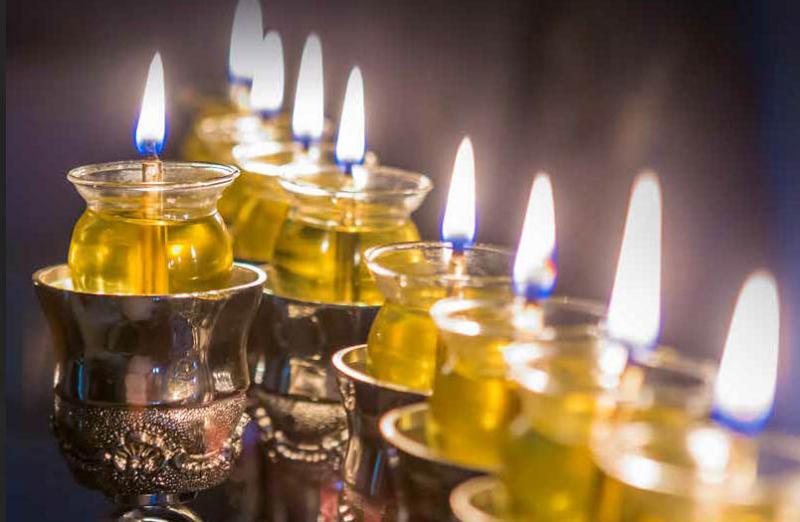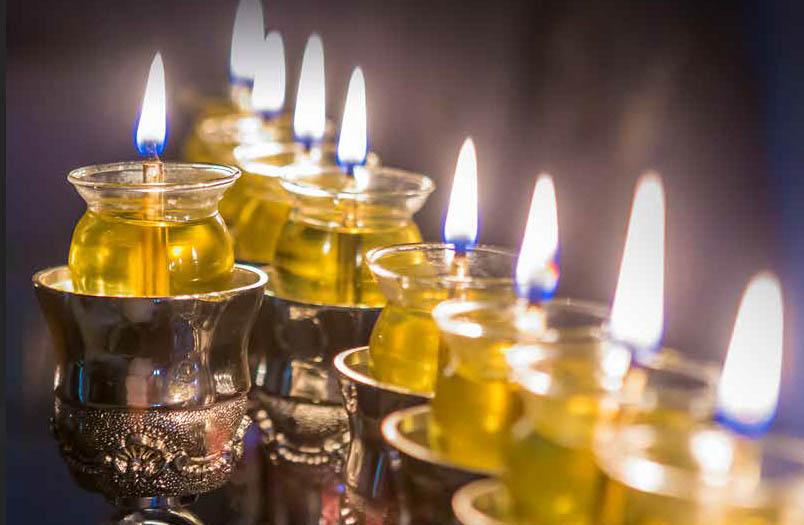
The Bible speaks of the menorah, or lampstand, on three levels: one in the Torah, one in the Prophets and one in the New Covenant. Moses was commanded to build a seven-branched golden lampstand and place it in the Holy Place of the Tabernacle (Exodus 25:31–40).
The priests were required to take care of the lampstand, but there was no clear teaching as to the spiritual meaning of the menorah. When there is no clear teaching on something in the Torah – such as the Feast of Trumpets – it is often because it can only be understood in light of the New Covenant.
In the Chanukah story, the Jews, led by Judah Maccabee and his small army, defeated the Syrian king, Antiochus Epiphanies. It was considered a miracle that this tiny army of Jews could defeat the massive Syrian force.
Antiochus Epiphanies devastated Jerusalem in 168 B.C.E. He defiled the Temple, offered a pig on its altar, erected an altar to Jupiter, and prohibited Temple worship [sacrifices]. He also forbade circumcision on pain of death, sold thousands of Jewish families into slavery, destroyed all copies of Scripture that could be found and slaughtered everyone discovered in possession of such copies. He resorted to every conceivable torture to force Jews to renounce their religion.
The Menorah
After the surprising Jewish victory, the temple, including the menorah, was rededicated by the Maccabees as they celebrated the new holiday of Chanukah (Chanukah means dedication). The Hebrew word for the Chanukah lampstand is Chanukiah. It has nine lights that represent the eight days the menorah in the temple remained lit, despite having only enough oil for one day (according to tradition) and an extra candle, called the shamash, that is used to light the others. Though most American Jews call this a menorah, it is not a replica of the tabernacle menorah. Nevertheless, it was clearly meant to represent the temple menorah in Jewish religious tradition, as it commemorates the miracle of the seven branched menorah during the temple’s rededication.
A Sign of Restoration
On the second level, the prophet Zechariah saw a vision of a mystical menorah with two olive trees – one to each side. This symbolized the Lord restoring Zion and the temple by the power of His grace and Spirit (Zechariah 4:1–10). This vision became the basis for the symbol and seal of the modern state of Israel.
The Body of Messiah
The third level is found in the book of Revelation, in which John has a supernatural vision of Yeshua in a glorified form, standing in the midst of seven lampstands. It is more likely, if we are going to be consistent with Scripture, that it was either a menorah that John saw, with seven branches, or seven menorahs with 49 lights in total. The word for lampstand in the Hebrew Scriptures is almost always menorah, a sevenbranched candelabra. In the Greek translation of the Old Testament, the same word is used for menorah as John used for lampstand in Revelation. In the Hebrew New Testament, lampstand is translated as menorah. Furthermore, the menorah(s) in Revelation are made of gold, just as God told Moses (Exodus 25).
Each branch of the menorah (or each menorah) represented the seven churches or congregations of Asia Minor (Revelation 1:12, 20), which are symbolic of all types and streams making up the international ecclesia, or body of Believers. And let’s not forget – everything in the temple was an earthly shadow of a heavenly reality (Hebrews 8:5). The menorah represents the worldwide body of Believers.
As the Mosaic lampstand found expression in Jewish religious tradition, Zechariah’s prophetic vision found expression in modern Zionism, and John’s vision pictures people of every tribe, tongue and nation being glorified by the power of God.
Unity Brings God’s Fire
We know that the menorah in the temple had to be built according to the pattern
God gave Moses (“See that you make them according to their pattern being shown to you on the mountain” (Exodus 25:40)). So, if John’s vision of a sevenbranched menorah was representative of the united body of Believers, then fire must also have meaning.
Without the menorah, you cannot have fire – certainly not a contained, managed, focused fire. Once the menorah was built, it could be lit. In the same way, when the Believers gathered on Shavuot (Pentecost) in unity – with one purpose and focus, waiting on the Holy Spirit – they became a spiritual menorah that could be lit, and the Spirit came as tongues of fire. In fact, the image of the 120 with flames of fire upon them is an image of one menorah with many branches. Each branch is on fire, doing the will of God.
When the menorah is in place – just as Yeshua instructed (“you are to stay in the city until you are clothed with power from on high” (Luke 24:49)) – the fire or Holy Spirit could not only fall upon, but also function through each Believer. The fruit was that 3,000 men, plus women and children, were born again that day.
The lesson is that, like the menorah, the body of Messiah must be built according to the heavenly pattern. Yeshua tells us in John 17 that His deep desire is for unity. Only when the body is in unity can the Spirit flow as He desires (Acts 2). Gossip, backbiting, dissensions, jealousy and the like all work to thwart the authentic fire of God.
Only the Servant Can Light the Candles
It is interesting that in Jewish tradition, it is that one special candle, the shamash, that leaves His special position above the other candles to come down and give light to the other unlit ones. Shamash means servant. Once the shamash has brought light to the other candles, He then takes His place, once again, above the others. Unbeknownst to most religious Jews, this is played out in Philippians 2:6–11:
Who, though existing in the form of God, did not consider being equal to God a thing to be grasped. But He emptied Himself – taking on the form of a slave [shamash!], becoming the likeness of men and being found in appearance as a man. He humbled Himself – becoming obedient to the point of death, even death on a cross.For this reason God highly exalted Him and gave Him the name that is above every name, that at the name of Yeshua every knee should bow, in heaven and on the earth and under the earth, and every tongue profess that Yeshua the Messiah is Lord – to the glory of God the Father.
Shine Your Light!
One more thing. According to Jewish tradition, we are to take the lit Chanukiah and place it in a window to declare the Chanukah miracle to all who would see it. Was Yeshua thinking of this (even though the tradition came later) when He said, “You are the light of the world. A city set on a hill cannot be hidden. Neither do people light a lamp and put it under a basket. Instead, they put it on a lampstand so it gives light to all in the house. In the same way, let your light shine before men so they may see your good works and glorify your Father in heaven” (Matthew 5:14–16)?
Or, “I am the light of the world. The one who follows Me will no longer walk in darkness, but will have the light of life” (John 8:12)?
You also might find it interesting to know that Yeshua himself celebrated Chanukah. In John 10:22, it speaks of Him being in Jerusalem for the Feast of Dedication (Chanukah).
What is the lesson?
- Strive for unity (Philippians 1:7)
- Expect the Holy Spirit (Acts 2:1–4)
- Let your light shine (Matthew 5:14–16)





